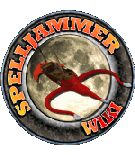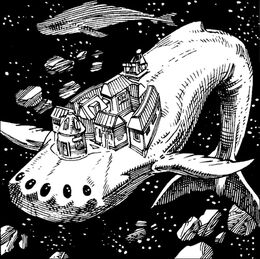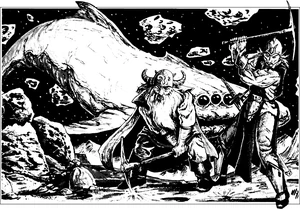A Kindori, or space whale, is a creature native to wildspace from the Spelljammer campaign setting.[1]
Overview[]
Kindori, also known as space whales, are among the largest living creatures found in wildspace.[1]
Description[]
A kindori is a mammal that resembles a terrestrial whale in general shape and form. However, a kindori lacks a noticeable mouth, and the leading edge of its fishlike body is dotted with a row of small eyes. A kindori is large enough to maintain its own gravity plane and air envelope, and has no need for air of its own.[1]
Combat[]
Kindori tend to be peaceful except when threatened. Normally this usually means a direct attack, but during herding season any individual approaching a herd may be seen as a threat.
A kindori's main physical weapon is its massive tail flukes, which it uses to batter its opponents. While kindori recognize the presence of small creatures such as humans or beholders, they direct attacks first and foremost against the ships that are almost their size. The kindori work together to batter a single attacker to bits, then go on to the next one, until all assailants are defeated.
The leading eyes of a kindori can emit a concentrated blast of light, projected as a cone 500-yards long with a base diameter of 400-yards across. All creatures caught within the cone may be blinded for up to 16 minutes. Kindori use their light attack against opponents they cannot defeat with their physical attacks, relying on the confusion created to escape.[1]
Habitat[]
Kindori normally travel in small pods of between 2 and 8 members. Larger pods of 7 or 8 members are usually defended by a large male kindori known as a bull.
Every so often (roughly annually, depending on the sphere), several pods will gather together into a larger herd of up to 30 members. There will usually be up to 6 bulls present in such a herd, and during this time, any ships that pass near the herd will be attacked. During herding season the male kindori are particularly violent, engaging in tail-slapping contests with other young males (and often with ships that come too close). These tail-slapping competitions create a pecking order within the herd, which in turn determines the mating rights of the various members. The oldest bulls always have first rights among the females, followed by the more powerful young males.
Kindori young gestate for six months and are born live in wildspace. A herd will be extremely protective during this time, since the young are prey to scavvers and other predators.
Kindori are so large that mosses, molds, and other living creatures grow on their backs, which in turn attract other creatures which feed on them. A kindori may support up to 18 gray or brown scavvers who feed on the growths on their sides.
Kindori do not eat in the same way other creatures do; instead they soak up the rays of any suns, stars, and other shining bodies in their area of wildspace. The “belly” of a kindori is dotted with tiny white patches, each of which absorbs energy which is sent deep within the creature, to be stored within its large mass. Keeping their bellies clean of parasites is a common social activity among kindori, as the great creatures rub each other to flake off old skin and parasites. They are less concerned with their backs, which is why small islands of life often spring up there.
An extremely old or sick kindori can be spotted by its overgrowth of vines and vegetation. Such creatures are near death, and often fall prey to larger scavvers and other predators. Kindori have many natural enemies, including krajen, radiant dragons, and various humanoid races. Beholders and mind flayers, sensitive to the creature's light-emitting eyes, particularly dislike them. The former will avoid kindori whenever possible, while the latter will engage in wholesale slaughter, massing armadas to take out whole pods that lie too close to their outposts.[1]
Uses[]
The flesh of the kindori can be rendered into oil, much like an aquatic whale, and it is this oil that is the primary ingredient in most types of alchemical fire used by various spacefaring races. Lizardfolk, who use greek fire regularly, often put together whaling parties to hunt kindori, and are working on constructing a mobile base, towed in pieces by multiple wasp-class ships, that can render the flesh of the creatures in the field.[1]
Domesticated kindori[]
Kindori are generally peaceful and have been domesticated by a number of primitive spaceborne societies. Such groups, known as "kindor-riders",[2] include humans, dwarves, elves, gnomes, and even halflings, and generally live in symbiosis with the great creatures. The "kindori-riders" either use the kindori for short distance travel between their communities, such as within an asteroid belt, cluster, or ring; or permanently live on the backs of the space-whales as far-ranging space nomads. The kindor-riders do not cut into the flesh of the kindori, but rather secure buildings, weapon platforms, and the like with short hooks that lightly snag the creatures thick hide. Because the kindori do not need to breathe, the kindori-riders often maintain farms and herd terrestrial beasts on the backs of these creatures.[1]
The kindori-riders will not attempt to split up kindori family groups, and a typical pod will number between 2 to 8 kindori, each with a population of up to 20 riders. These people's whole lives revolve around the care and welfare of the massive creatures. The tribe will clean the scavver barnacles from the kindoti's tender underbellies, ward them from possible dangers and and make sure the overgrowth of vegetation does not interfere with the creatures ability to see.
The kindori-riders are able to control the pod except during herding season. The kindori herding instinct that occurs every year causes the kindori population to grow increasingly aggressive as they establish breeding rights. During this month-long period, the kindori-riders can do nothing except hold on. The violent tail-slapping and furious ramming can rip whole villages off the backs of male kindori. This explain the rarity of villages built on the back of males, except for the most venerable of males. The female kindori, which are generally larger than the males, are far more stable and a better choice to establish a settlement.[2]
Kindori-rider's vary in organization and technology level, and range from empires ruled by philosopher kings, to savage degenerate marauders who attack everything in sight. War parties generally consist of warriors armed with the best weapons they can muster, from bone spears and ivory breastplates to bronze armor and short swords, and will usually be led by a captain or a shaman. Kindori will be armed with a light catapult, though the larger bulls are able to carry a heavy catapult. Old solitary bulls are usually deployed on scouting or exploration duties.
Some kindori that have been domesticated may go feral after their masters die or let them loose. These kindori sometimes have the ruins of old buildings (generally called howdahs) on their backs, along with more terrestrial plant and animal life. Such structures and life survive only on the back and sides of the kindori.[1]
Notable Kindori-riders[]
- Stefano was an elderly human and chieftain of the Kindori-Riders of Krynn.[3]
- Elke was the wife and chief advisor to Stefano, chieftain of the Kindori-Riders of Krynn.[3]
Spelljammers[]
Even in death kindori are powerful creatures, as their skeletons do not decompose after their flesh has been consumed. Undead creatures such as liches and vampires often mount helms on skeletal kindori and use them as ships during slow, leisurely invasions of new spheres.
There have been reports of attempts to mount a spelljamming helm on a living kindori, though it is generally acknowledged that moving at spelljamming speeds spooks them, and even domesticated kindori will head off for parts unknown, seeking to scrape the irritating helm from their flesh.[1]
Appendix[]
Gallery[]
External Links[]
- Kindori article at the Advanced Dungeons & Dragons 2nd Edition Wiki, a wiki for official Dungeons & Dragons content from 2nd edition AD&D.
References[]
- ↑ 1.0 1.1 1.2 1.3 1.4 1.5 1.6 1.7 1.8 Jeff Grubb. AD&D Adventures in Space; Lorebook of the Void, TSR, Inc., 1989, Kindori (Space Whale) entry (pp.79–80)
- ↑ 2.0 2.1 Dale "Slade" Henson, War Captain's Companion, War Captain's Guide, 1992, (TSR Inc.), chapter 3: Spacefleets of the Void, page 24
- ↑ 3.0 3.1 Dale "Slade" Henson, War Captain's Companion, War Captain's Guide, 1992, (TSR Inc.), Personalities section, chapter 3: Spacefleets of the Void, page 26


